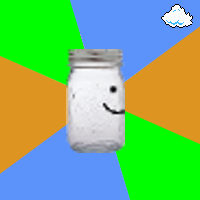I’ve just pushed an update to Jario with some pretty nice changes since I last mentioned it. As usual, you can check out the source if you’re interested or just ![]() !
!
I’ll be quick:
Features:
- All the important items – coins, mushrooms, fire flowers and stars.
- Goombas, Koopas and even empt shells, with the ‘proper’ graphics and animations.
- Vastly improved input and collision handling.
- Added a marginally more satisfying ending, though it still doesn’t do anything.
- Fixed many, many bugs (but not the intermittent collision mesh one yet).
Architecture:
- Cleaned up collision handling systems into a hierarchy of similar handlers for increasingly concrete entity types. I’ve found it to be very flexible and reusable so far, which is nice, since the logic of a game is little more than input and collisions.
- Refactored image and animation spatials into a hierarchy of intermediate abstract classes, and added a SpatialComposer to group the different spatials of individual entity types and handle different states.
- Inserted a hierarchy layer for spatial effect handling. Currently only processes changes in rendering alpha value, but does so quite nicely.
- Played around with a TimerSystem to be used in conjunction with a Timer component, allowing systems to easily register callbacks with individual entities to be executed after a given delay. Makes it very easy to add temporary properties to entities. For instance, giving the player X seconds of invulnerability (hurt with >1 health, or press I) reduces to a single static function call. Still need to play with Artemis’ DelayedEntityProcessingSystem to see if that does a similar thing.
That’s all the significant bits so far. Still plenty more to go, though! Some of the above will need to change in order to support a complete level, which will be interesting. I also need some better game state transitions, though that’s nothing to do with Artemis. I’ll talk a little bit about some of the more interesting points soon, such as the collision handling and spatials, since those two are key to getting a game working smoothly.
